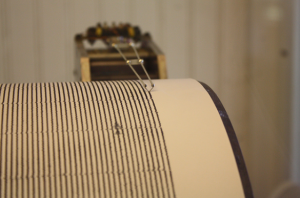 Californians pride themselves on being prepared for a major and catastrophic earthquake, and to their credit they have given more thought and practice to how to respond when the big one comes. But, our country has many, many earthquake-rich areas, and a lot of our citizens have no idea what to do if a huge quake hits their area. Almost every region of the United States, from Hawaii to Maine have fault lines, hotpsots and compression points that can snap at any time. We are conditioned to believe that the vast majority of quakes are minor tremblers that will do minimal damage. This is true, but there are also many times when a huge an unexpected quake will wipe out an entire city or region, and it happens around the world all of the time.
Californians pride themselves on being prepared for a major and catastrophic earthquake, and to their credit they have given more thought and practice to how to respond when the big one comes. But, our country has many, many earthquake-rich areas, and a lot of our citizens have no idea what to do if a huge quake hits their area. Almost every region of the United States, from Hawaii to Maine have fault lines, hotpsots and compression points that can snap at any time. We are conditioned to believe that the vast majority of quakes are minor tremblers that will do minimal damage. This is true, but there are also many times when a huge an unexpected quake will wipe out an entire city or region, and it happens around the world all of the time.
Being prepared for the big one in California is a best guess situation to begin with, but at least the population has some sort of experience when it comes to how to respond and what to do. However, the biggest challenge they face is that many residents are cut off from the rest of the country if their areas turn in to piles of rubble. Due to mountain ranges, deserts and wide open spaces between cities and resources, the only way in or out of most areas in California are by a few highways that will most likely be destroyed when a big quake hits.
Supplies, services and resources can be seriously limited, and many people will need to fend for themselves for quite some time until help can arrive. While most of the rest of the country is ill-equipped or prepared to handle the aftermath of an earthquake, they are better situated to have more options that can help making the aftermath more easy to cope with. For example, if a major quake hit along the New Madrid fault in western Tennessee or southern Illinois, people would have access to more resources, and help could be shipped in through a number of different routes. Evacuation to other locations would be easier as well.
Earthquakes are a part of our lives, no matter where we live. The crust of the earth is a thin, fragile and brittle surface that floats on top of a gooey, hot, swirling and bubbling bed of mantle- lava and melted rock. It really doesn’t take much for the ground to crack, buckle and compress, and it can happen anywhere- even in places that have never experienced such an event before. Everyone should be ready and equipped to respond to the immediate as well as long-term effects that a severe earthquake will produce. Food and gas shortages will occur. Water pipes will burst, and natural gas lines will rupture. Power will be shut off, and all of this will take days or weeks to recover from.
An Earthquake survival kit for your home, car and person is essential. Everyone should have at least a week’s worth of supplies and tools in their home. Cars should have basic survival kits and you should also have a bug-out-bag that includes basic resources such as high-energy food bars, a poncho, survival knife, first aid kit, water purification tablets and a radio at a MINIMUM. You never know what you will need to do after an earthquake, so you should have all of your bases covered so that when the big one comes you will be ready.
Never underestimate the power of mother nature, and remember that we can never contain or control what the earth can do. The best thing is to be prepared and have options that can be used to promote your survival. Earthquakes happen suddenly and without warning, and you will never know the extent of devastation and destruction that is possible until it happens. You may face the prospect of having to ply through rubble to get to safety. You may find out that your hospital has been destroyed and that emergency services are non-existent. You may realize that the only way to safety is by going through the wilderness until you can reach another town twenty miles away.
All of these are realistic possibilities that any one of us may encounter, especially if a quake hits in an area that has never experienced one before. It may take days or weeks to have access to food, health care services and fresh water. You may be trapped and in need of rescue, and you may be injured. Consider all of these factors and then decide how to best prepare yourself for the worst, because it will happen…it’s just a matter of time, and you need to be ready to respond and survive. Complacency is the enemy of survival, and start to prepare now so that you will know what to do later.